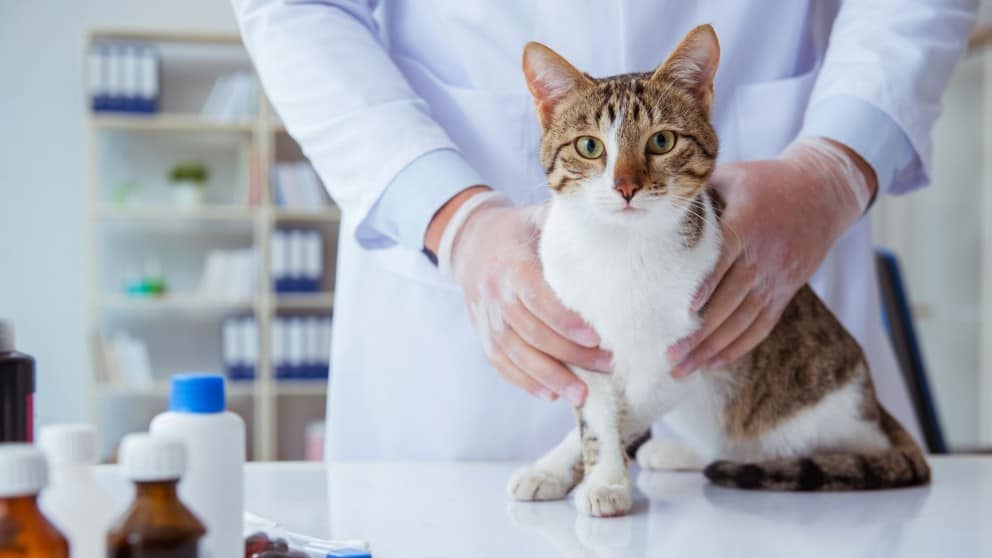Understanding Vet Visit Costs and Getting the Best Deals

As any seasoned pet owner will tell you, pet ownership can get expensive. The annual costs go well beyond just food, a collar, and a leash. Dogs and cats need consistent preventative care and annual treatment in order to stay healthy and happy.
Before bringing a new dog or cat into your home, you need to consider if you are able to afford the long-term costs. While the average life expectancy for dogs is 8-13 years old and 17 years old for cats, some breeds can live well beyond that.
It’s a commitment that requires patience and consistency. And along with your average vet visits, you will also need to factor in the cost of pet health insurance and potential emergency visits. With that said, there are a few ways to help reduce the costs of pet ownership while maintaining a great lifestyle for you and your pet.
Tips on Reducing the Cost of Pet Ownership
One-time pet expenses
A bulk of your pet expenses will go toward those initial one-time purchases. It can be easy to stock up on fun and inexpensive toys and bedding when you first bring your furry friend home, But, in our opinion, it’s best to go for quality and sustainable products that will last you years.
Examples of what your initial pet expenses for cats and dogs will cost include:
- Adoption Fees $0-$500
- Spaying or Neutering $35-$200
- Microchipping $25-$50
- Initial Vaccinations $60-$150
- Leash and Collar $50-$120
- ID Tags $10-$25
- Crate $40-$150
- Food and Water bowls $10-$60
- Bedding $25-$199
Some of these typical costs will vary depending on where you live in the United States or beyond.
Preventative Care
From food, treats, and toys to annual vet visits, prescriptions, and grooming, being a responsible pet parent means dedicating a monthly budget toward your pet’s well-being. One of the best ways to reduce the long-term costs is to focus on preventative care and daily maintenance.
The best part about preventative care is that it all starts at home. This gives you more flexibility to find solutions that fit your budget while meeting your pet’s needs. These are some preventative care aspects you should focus on:
High quality diet: Feeding your dog or cat a low-quality diet that’s full of fillers and preservatives can cause a series of health concerns later down the road. Issues such as allergies, skin lesions, shedding, gassiness, loose stool, and lipoma lumps can all be caused by poor quality pet foods.
Beware of ingredient lists that include meat meal, animal byproducts, BHA/BHT, artificial coloring, MSG, corn, corn syrup, gluten, xylitol, soy, nitrates, cellulose, and chicken/beef/turkey/lamb “flavorings”. It’s possible to find a diet that’s both tasty and meets your pet’s nutritional needs, it just might take some time.
Daily exercise: Dogs in particular need at least 30 minutes of exercise every single day. With larger or more active pets, an hour is recommended. Providing your pets with some form of exercise will help maintain their weight and avoid the chance of obesity.
Grooming: Yes, even cats need regular grooming. A regular grooming schedule can help save your pet from external health concerns and provide you the opportunity to consistently check for abnormal conditions such as lumps, rashes, etc.
Depending on the breed of your pet, below are the regular grooming activities you’ll need to do:
- Brush teeth – Daily
- Brush coat – Every 1-3 days
- Clean ears – As needed
- Bathe – Every 3-4 weeks
- Clip nails – Every 3-4 weeks
- Hair trim – Every 8-12 weeks
Of course, proper veterinary care and physical exams are also an essential part of being proactive about your pet’s health. This includes:
Annual Vet Exam and Vaccinations: Even if your pet is healthy, it is always a good idea to take them for an annual vet exam and stay updated on your vet’s recommended vaccinations. As your pet gets older, the vet will likely recommend an exam every 6 months. These exams will help you prevent more costly health issues from developing.
Flea and Tick Prevention: For those pet parents who live near wooded areas or do a bit of hiking/outdoor activities, consider applying a regular flea and tick medication. There are many options on the market that will help prevent these nasty bugs from attacking your pets.
From topical treatments to collars and shampoos, they can all help avoid infestations. Your pet’s annual exam is also a great time to get their vaccinations. These will likely include the core vaccinations for dogs – DHPP and Rabies – and for cats – FVRCP and Rabies.
Heartworm Prevention: Heartworm disease can cause serious health issues in dogs and cats. An infected pet can suffer from lung disease, heart failure, organ damage and even death.
These parasitic worms are spread when an infected mosquito bites your dog or cat and the larvae matures into adult worms. The best treatment is prevention via an oral tablet or topical treatment that can be prescribed by your veterinarian. You might then give your pet their treatment at home.
Cheaper Prescriptions
Another great way to lower the cost of pet ownership is to find a cheaper prescription source. Most veterinarians can fill prescriptions in-house however will charge a high margin increasing the overall cost.
Companies like PetCareRx offer discounted rates on popular pet prescription medications. They will contact your vet to get the written prescription and ship you your pet’s medications within a few business days. This is an easy way to lower costs on regular medications.
Group training costs
If you are a new pet owner or want to get your older pet some recurring training, look into group training programs. To put in perspective, a private lesson will cost an average of $45-$120 per hour. A group less will cost around $30-$50 per hour.
When you’re paying for around 4-6 lessons, that’s a big savings! These training sessions can also be priceless since they can turn your pet into a great canine or feline citizen while teaching him or her valuable socialization skills.
Vet Visit Costs & Prices
Keeping your companion healthy and happy will always be important but we can’t ignore the fact that vet bills are expensive. Even though you take great care of your pet and you care dearly for them, neglecting vet visits means you’re not doing everything in your power to keep your furry friend healthy.
Unfortunately, it’s a challenge to estimate the average cost of a vet visit for a dog or cat simply because it varies so much based on your location, breed, gender, and other factors. For the sake of this guide and to help out concerned pet parents, let’s do our best to estimate what we think the costs could be for your pet.
Average Vet Costs for Dogs
Your first-year vet visit cost will vary based on the size of your dog:
Small dog: $1,471
Medium dog: $1,779
Large dog: $2,008
Some people may think that puppies or kittens have higher veterinary bills. However, this isn’t always the case. No matter if you have a young pet or are adopting an older pup, it’s his or her first vet visit that will likely be the most expensive because of the tests that will need to be done.
This first vet visit is important for understanding your pet’s health and for your vet to record his or her baseline wellness. You might also opt for additional services during this visit, like microchipping.
Keep in mind that the variations in cost have nothing to do with the health of your pup. It has everything to do with the number of products needed to care for a larger dog.
Over the course of your pup’s life, you can expect to spend anywhere between $7,565-$19,060. This will cover food, medicine, vet visits, spaying, neutering, dental work, vaccinations, flea and tick control, heartworm tests, other diagnostic tests, and more.
Vet Costs for Cats
The average first-year cost for a cat is $1,174. Many of the same upfront costs you’ll run into with a dog, you’ll also experience with a cat. You’ll likely have to take them for that first vet visit, purchase flea and tick medication, and maybe you want to get them fixed.
A typical lifetime cost for a cat is $9,150. Cats generally live longer than dogs, but they don’t require as many trips to the vet because they’re not quite as curious as their canine friends.
Dogs tend to get themselves into situations where they hurt themselves or ingest foreign bodies. Cats aren’t as prone to doing this and are inherently more nimble so you will avoid large-scale emergency expenses here.
How Much is a Vet Visit? Specific Treatments
If you’re bringing your pet in for something specific, it’s a bit easier to determine that vet visit cost. Here are some average costs across the country:
Grooming – $30-500 yearly
Flea and Ticks – $40-200 yearly
Spay or neuter – $50-200
Teeth cleaning – $100-300
Vaccinations – $10-100
Heartworm – $50
Intestinal – $200-385
Of course, keep in mind that these costs are rough estimates and may vary based on your location and the severity of the situation. Asking yourself “how much does a vet visit cost” will bring about a lot of results, but there are many different options for covering the payment of an unexpected visit.
Many vets will allow you to split up payments, develop a payment plan, or apply for a pet-specific loan. Pet insurance is the best way to ensure you don’t find yourself in a difficult situation when it comes to paying for vet costs across the board.
How to Choose a Vet
Choosing the right veterinarian for your dog is something that you should carefully consider even before you take your pet home. This is the person that could potentially save your pet’s life and keep them healthy. Both you and your pet should come to a consensus about this person before you make a long-term commitment to work with them.
Here are some things to consider when choosing a veterinarian.
One of the best ways to find the right veterinarian is to ask your friends and family members for recommendations. Before you go browsing through Yelp reviews, there are likely other families with pets in your area that may know some good veterinarians to check out, so that should be the first place you look for advice.
When calling to inquire about making an appointment, consider the staff’s attitude. If it’s difficult to book an appointment or get a straight answer to your questions, think about how you’ll feel when you have to call in about something more serious.
When choosing a vet, keep in mind their overall personality. Are they calm and do they have a good bedside manner? Does your pet seem to like them? A good vet will know how to soothe a stressful situation instead of adding to it.
Being comfortable around your veterinarian is important because you should be able to tell them everything about your dog. The same applies to your dog because they should feel at ease around the vet. Some initial discomfort around a vet can be normal for some dogs, but signs of anger, fear, or distress toward a vet is certainly a red flag that you should move on.
Luckily, you may find that you have a few veterinary options to choose from in your area. This can help you find your perfect fit for your pet. Remember that since most pet’s only need an annual or bi-annual checkup, it can be worth choosing a vet a bit farther away if you like them.
Quality Over Cost
Make sure that the vet you’re choosing has plenty of services available. A good veterinary practice will give you access to services such as x-rays, blood pressure monitoring, ultrasound, in-house lab diagnostic tests, and even dentistry.
You may want to check out what kind of equipment is available within the practice and who is qualified to use it. Also, knowing whether they have a method of monitoring overnight patients will give you peace of mind if your pet needs to be admitted to the surgery.
There’s no doubt that caring for your pet can sometimes be a costly business. Make sure to ask questions like does the vet have fixed costs for set procedures, or do they give full quotes before going ahead with treatment? They should be transparent with this information so you can determine if it works for your budget and needs.
Getting a Second Opinion
Your pet and their health is a matter that’s close to your heart, so even when you’ve found your vet, you may want a second opinion on a particular subject. Remember, you are the pet owner and ultimately the final decision maker when it comes to your pet’s health.
With a serious diagnosis, a surgery or a test recommendation can turn your world upside down and getting a second opinion could do wonders when it comes to setting your mind at ease.
Emergency Pet Hospitals
Unfortunately, accidents do happen. When a medical emergency befalls our furry friends, pet parents may find it difficult to make rational decisions, especially if something occurs at night. That’s why it’s crucial to have an emergency plan in place before it’s too late.
Talk to your veterinarian about an emergency protocol. Does your vet provide 24-hour service, or does he or she work with an emergency clinic in the area? Some practices have multiple veterinarians on staff who rotate on-call services after hours.
Check to see if your primary care vet has partners who might answer an emergency call. It’s also a smart idea to keep the name, number, and address of your local emergency clinic in an easily accessible location.
Covering an Expensive Vet Bill
Vet bills can be hefty, and they can add up quickly. Whether you’re there for routine vaccines or emergency X-rays, your vet may have options for payment other than putting it on a credit card with a high APR. Many vets will offer great service rates for cash payments made in full or have other in-house options. There’s no harm in asking your vet what offers are available, especially when getting your pet the proper care they need.
Here are a handful of options to consider when it comes to lowering your cost for a vet visit:
House Accounts and Split Payments: Some veterinary practices will offer credit lines to customers or will offer the ability to make payments over time. Many will require a credit card on hold before services are rendered and ensure the negotiated payments are made. Having a house account or split payment plan can help your pet get the treatment he or she needs without having to break the bank all at once.
Pet Specific Loans: If faced with a large bill that you can’t cover with a credit card or other payment method, you may consider a pet-specific loan. As with credit cards, the APR can be quite high ranging from 8-29.99% for up to 72 months.
Pet Insurance: Did you know the average cost of an emergency vet visit is between $800-$1,500 and can cost upwards of $10,000 for serious procedures? This is where pet insurance becomes truly worth it.
Pet insurance can help prevent heavy financial burden in case of unexpected and expensive vet care emergencies. They offer affordable monthly payment plans and, depending on your policy, will reimburse you up to 90% of the costs. Having pet insurance gives pet owners peace of mind knowing they will be able to afford an unexpected treatment and mitigate those large bills.
The Low-down on Pet Insurance
When it comes to reducing veterinary costs, pet insurance is something all pet owners should consider. Pet insurance is a great way to help pet owners reduce the financial burden of unexpected and expensive vet care. It also allows pet owners to get the best possible care for their dog or cat without worrying about what’s in their bank account.
There is much more to proper pet coverage than finding the cheapest insurance rates. Here are a few things to look for when choosing a pet insurance provider:
Type of Pet Insurance Plan
When looking for pet insurance, consider what type of coverage your pet needs. Not all plans are the same so doing a bit of research and comparing coverage will help you figure out what the best option is for you. For instance, one of the biggest differentiators in pet insurance plans are those that cover preventative care and those that cover emergencies.
Here are some of the most popular pet insurance plans available on the market:
Accident-Only Plan: This type of plan will cover most unexpected harm or injuries caused by an accident such as broken bones or bites from another dog or animal. However, as with most pet insurance plans, pre-existing conditions will likely not be covered. An Accident-Only Plan is a budget friendly option for dogs and cats with a clean medical history that may only need to visit the vet for annual check-ups or in case of an accident.
Accident & Illness Plan: Most pet insurance providers will offer an unexpected Accident and Illness Plan which will cover not only a broken leg or bite but things such as ingesting a foreign object to something more serious like cancer. Like the Accident-Only Plan, pre-existing conditions or diseases that have a recommended vaccine may not be covered.
If your pet has had a pre-existing condition such as Addison’s Disease, Cushing’s Disease, Diabetes, Cancer, Feline Leukemia or Feline Immunodeficiency Virus, the insurance company may only offer you an Accident-Only Plan as an option. An Accident and Illness Plan is a good option for most breeds especially those prone to genetic concerns such as hip dysplasia or respiratory problems.
Comprehensive Plan: A comprehensive plan will include not only the Accident and Illness Plan but access to preventative care with a Wellness or Routine Care Plan. This plan will usually provide an annual credit toward preventative treatments such as flea and tick medication, heartworm prevention, annual vaccinations and microchipping. This option is great for the ongoing care for your dog or cat.
Flexible Insurance Premium
If you’re on a tight budget, look for a pet insurance provider that has flexible coverage options that let you choose the amount of annual coverage you need. Instead of being forced to choose a one-size-fits all policy, a flexible plan will let you choose your annual limit, deductible and reimbursement percentage. All of these will help determine your monthly insurance rates without sacrificing proper coverage.
Age Restrictions
Before deciding on a pet insurance company, research whether or not the plan has any age restrictions. The last thing you want is being dropped from your insurance company because your dog or cat has become too old for coverage.
Maximum Annual Limit
Before choosing a policy, be sure you understand the maximum coverage your pet’s policy will cover. This is called an annual limit and it’s the maximum amount of money the pet insurance company will pay toward your pet’s ongoing health in any given year.
There are a few ways your pet insurance plan will categorize the claims basis, or how they determine to cover the vet fees. The annual limit covered for a pet policy can be:
- Per Year in which all qualified conditions are covered up to a certain amount each year. The annual amount resets each year.
- Per Condition in which a particular covered condition has a maximum allowance per year. Once that amount is reached, you will need to pay out of pocket or wait until the annual allowance resets.
- Total Per Condition in which the covered condition has a maximum limit in total. The limit does not reset each year, it’s simply a set amount over the course of a lifetime.
Plan Ahead Financially
While we all wonder as we drive to our veterinarian, “How much is this vet visit going to cost?,” we can assuage those concerns somewhat by planning ahead. We all understand that vet visit costs are part of owning a pet, but we do not know how much it will cost to see a vet on a specific visit or the average cost of a vet visit for several clear reasons. Every dog and cat is unique, as are his or her health challenges.
Regardless, all pet owners know that the vet is going to be part of their future. Pet insurance is obviously a very good idea for countless reasons, but so is putting a little bit of money away each month to prepare you for what is at least somewhat inevitable.
Even with pet insurance, you’re still going to pay some of the costs, so rather than be faced with difficult choices on which bills to pay or whether or not to go into consumer debt based on how much a vet visit costs, have some money ready to handle this eventuality.
Even if you put $100 per month into some type of account for safekeeping, you’ll have $1,200 at the end of every year and likely several thousand dollars ready when your pet gets older and is more likely to encounter health problems. If you take that step, how much a vet visit costs will no longer be something you worry too much about.
Final Thoughts
Like with anything, getting the best deals and saving money on vet costs and on-going pet care is achievable with research and comparison – it’s a good idea to shop around. And while not always the cheapest option, bear in mind that quality products and treatment will provide you and your pet with the best long-term results. Don’t forget to look into supplemental benefits that you might need to keep your pet healthy!
How often should you be taking your pet to the vet? Read more here.



